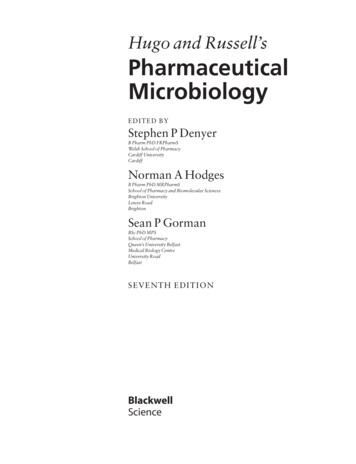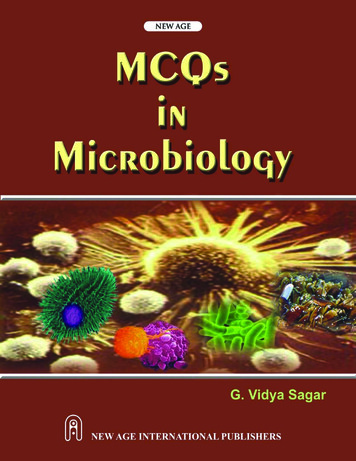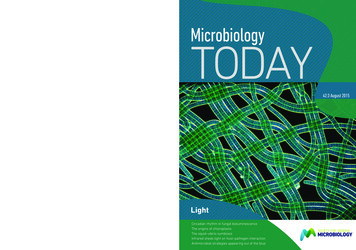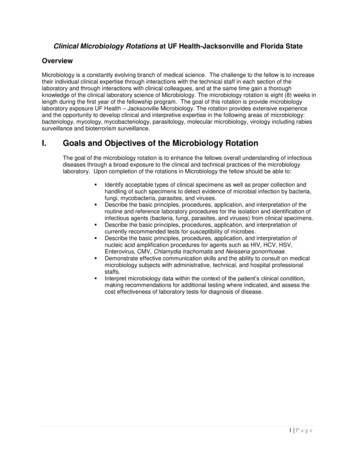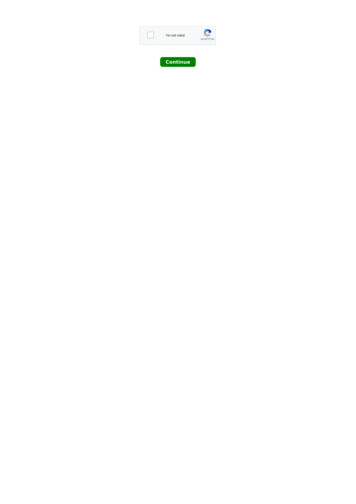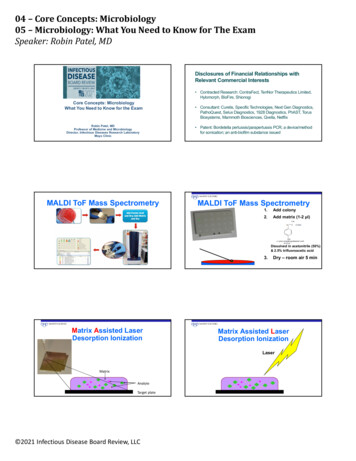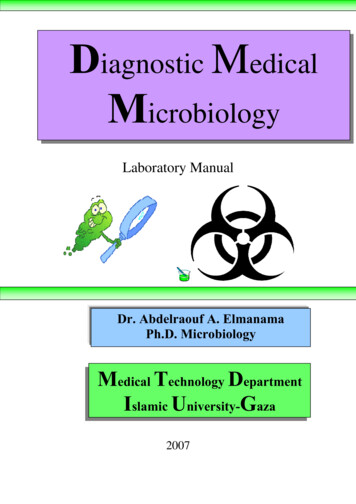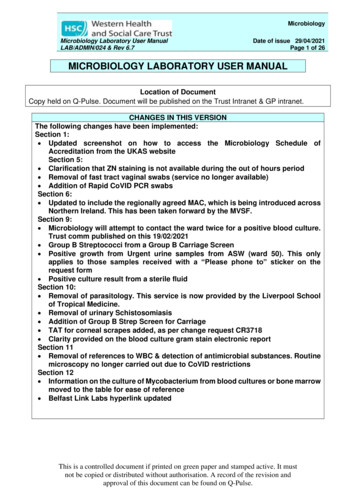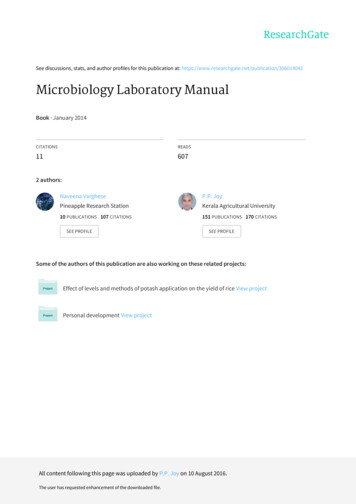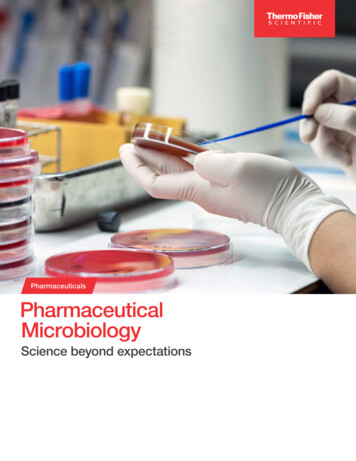
Transcription
PharmaceuticalsPharmaceuticalMicrobiologyScience beyond expectations
ContentsIntroduction 3Pharma workflow and Pharmacopeia4Overview of key markets5Sterility of the media6SterilityGrowth promotion test7Method of suitability8Product validation 12Media-fills 16Environmental program 23Non-sterilityNon-sterile pharmaGrowth promotion testMethod of suitabilityAbsence test and enumeration test2Science beyond ology
IntroductionPharmaceutical industries based on their manufacturing pattern can be broadlyclassified into the following categories:1. Sterile pharma and biopharmaInjectables, sterile ophthalmic drops, ointments,monoclonal antibodies (MAbs) and vaccines2. Non-sterile pharmaTablets, capsules, ophthalmic drugsSterile: Absence of microbes in a product.Sterility testingThe testing which confirms the absence of microbial presence in the products isknown as sterility testing. Sterile pharmaceutical ingredients, medical devices andmaterials claimed to be sterile undergo strict sterility testing to ensure they adhereto regulations. The sterile products are produced in the cleanroom environmentfree from any microbial contamination.The testing methods which ensure the product sterility state that a positive result(microbial growth) after 14 days at appropriate temperature (7 days incubation at20 C - 25 C followed by 7 days incubation at 30 C - 35 C) is considered afail, whereas negative results shows that the product is sterile. The sterile productscan be produced either by following aseptic manufacturing techniques or terminalsterilization.Non-sterileUnlike sterile pharma manufacturing, non-sterile pharma products do not requirethe cleanroom environment to be completely free from any microbial presence.Science beyond expectationsthermofisher.com/pharmamicrobiology3
Pharma manufacturing workflowPharmacopeiaHarmonized PharmacopeiaThe term “Pharmacopeia” has been derived from Greek words“pharmakon”, which means drug, and “poiein”, meaning to make.Thus, Pharmacopeia is a manual which provides information on United States Pharmacopeia (USP) European Pharmacopeia (EP) Japanese Pharmacopeia (JP)drug manufacturing.To streamline the process of drug manufacturing across theglobe, the above mentioned three pharmacopeias have beenharmonized to form the “Harmonized Pharmacopeia”.Apart from the aforesaid Pharmacopeia, there are numerousother pharmacopeia globally which vary from one country toanother. Among these, British Pharmacopeia (BP) is also widelyaccepted among the commonwealth countries, which comprises54 countries, and a combined GDP estimated to reach 13 trillionin 2020. Similarly, China and India have separate Pharmacopeiaknown as Chinese & India Pharmacopeia (CP & IP), respectively.4Science beyond expectationsthermofisher.com/pharmamicrobiology
Overview of key marketsDrug export market and key players1.During 2019, the total business from drug and medicines from export was 56.9 billion (14.5%)USD 392.9 trillion.The highest dollar value of business registered by different countries is highlighted on the2.Switzerland 47.8 billion (12.2%)right-hand side, with percentage of share. The tally is lead by Germany, which exportedUSD 56.9 billion worth of medicines and drugs in FY 2019.Germany3.Similarly, for FY 2019, the United States topped the chart in drug imports from otherNetherlands 31.1 billion (7.9%)countries. China, India and Mexico sell maximum drug and medicines in US market.4.Belgium 29 billion (7.4%)No.ImportercountriesRevenue with % share1.United States 78.9 billion (18.7% of imported drugs/medicines)2.Germany 30.9 billion (7.3%)3.Belgium 24 billion (5.7%)4.China 21.5 billion (5.1%)5.Switzerland 21.3 billion (5%)6.United Kingdom 18.8 billion (4.5%)7.Netherlands 17.5 billion (4.2%)8.Italy 17.3 billion (4.1%)9.Japan 17 billion (4%)10.France 15.8 billion (3.8%)11.Spain 11 billion (2.6%)12.Russia 10.2 billion (2.4%)13.Canada 8.3 billion (2%)14.Australia 5.3 billion (1.3%)15.Poland 5.2 billion (1.2%)5.France 26.2 billion (6.8%)6.Italy 24.8 billion (6.3%)7.United States 24.3 billion (6.2%)8. United Kingdom 18.3 billion (4.7%)9.Ireland 17.9 billion (4.6%)10.Denmark 15.5 billion 4%)11.India 14.8 billion (3.8%)12.Spain 10.1 billion (2.6%)13.Sweden 8.2 billion 2.1%)14.Canada 7.5 billion (1.9%)15.Austria .8 billion (1.5%)Science beyond expectationsthermofisher.com/pharmamicrobiology5
Sterility of the mediaThere are mainly two types of media that are used in sterility:Sterility check for the mediaThis is a pre-requisite step, which states that the sterility testinga.Fluid Thioglycollate Medium (FTM)b.Tryptone Soya Broth or Soyabean Casein Digestmedia is sterile (free from any microbial contamination), prepareMedium (TSB or SCDM)FTM and TSB media and incubate the same at appropriatemedium must not contain any contamination. To ensure thetemperatures for a total of 14 days. There should not be anyThe composition of the media used for sterility testing mustturbidity in the media after the said period.comply to the Harmonized Pharmacopeia (USP/EP/JP).Dehydrated culture media sterility for 14 days14 daysPassClear mediumFailedTurbidity/hazy mediumDehydratedIn-houseculture mediumpreparationIncubatorReady-to-use media or PPM sterility testing for 14 daysPassClear mediumFailedTurbidity/hazy mediumIn-housepreparation6IncubatorScience beyond expectationsthermofisher.com/pharmamicrobiology
Growth promotion test (GPT)GPT for media as per harmonized SterilityTestsEach lot of media undergoes a growth promotion test, regardlessof whether it is prepared or dehydrated culture media. In a growthpromotion test, the media is inoculated with 100 CFU of thementioned Quality Control (QC) organisms.Clostridium sporogenes, Pseudomonas aeruginosa, andStaphylococcus aureus organisms are inoculated in FluidThioglycollate Medium and incubated at 30 C - 35 C for 3 days.Similarly, Aspergillus brasiliensis, Bacillus subtilis, and Candidaalbicans are inoculated in Tryptone Soya Broth at 20 C - 25 Cfor 5 days (fungi) & 20 C - 25 C for 3 days (bacteria).Science beyond expectationsThe media are suitable if a clearly visible growth occurs.There are mainly two types of culture strains that are available inthe market; crude cultures, which are required to undergo serialdilution prior to the use, and commercially-available, ready-to-useculture strains. As per the regulatory-set standards the culturestrain standards should not exceed the fifth passage or subcultures.Please refer to the non-sterility growth-promotion section for theworkflow.thermofisher.com/pharmamicrobiology7
Method of suitabilityThe method for suitability test ensures that any antimicrobial agent present in the product can be effectively neutralized or inhibitedand there will be no microbial growth inhibition due to the same. This is an important test for new products and/or change/modificationmade in the original experimental set-up. This test ensures that if products contain contamination, it can be grown in suitable media inorder to seize the release of contaminated product(s).Suitability test can be performed by:1. Membrane filtration method2. Direct inoculationAs per USP 71 , EP 2.6.1 & JP 4.06 , the membraneIn this method, the product has been directly inoculatedfiltration sterility method is the method of choice for suitability ofinto suitable culture media and spiked with 100 CFU of QCfilterable pharmaceutical products. In this method, the productorganism. The product is then placed into the incubator for 3has been passed through a membrane filter and then 100 CFUdays for bacterial growth and 5 days for fungi growth. Clostridiumof the QC organism is inoculated in the rinsing fluid and filteredsporogenes, Pseudomonas aeruginosa, and Staphylococcusthrough the same membrane.aureus organisms are inoculated in Fluid Thioglycollate Mediumand incubated at 30 C - 35 C for 3 days.The membrane filtration can be:a.Open Membrane Filtration (OMF) orb.Closed Membrane Filtration methodSimilarly, Aspergillus brasiliensis, Bacillus subtilis, and Candidaalbicans are inoculated Tryptone Soya Broth at 20 C - 25 C for5 days (fungi) & 30 C - 35 C for 3 days (bacteria).In both types of membrane filtration methods, the growth of theproduct containing media vessels will be compared with thecontrol vessel (without the product). This is to ensure that growthof the QC organisms was not inhibited by the presence ofantimicrobial substances in the product. The growth of the vesselcontaining product and without product must be comparable topass the test.Clostridium sporogenes, Pseudomonas aeruginosa, andStaphylococcus aureus organisms are inoculated in FluidThioglycollate Medium and incubated at 30 C - 35 C for 3 days.Similarly, Aspergillus brasiliensis, Bacillus subtilis, and Candidaalbicans are inoculated Tryptone Soya Broth at 20 C - 25 C for5 days (fungi) & 20 C - 25 C for 3 days (bacteria).8Science beyond expectationsthermofisher.com/pharmamicrobiology
1. a. Method suitability: Open Membrane Filtration (OMF)Step 1: Pass the liquid sample through filter membrane(with pore size not greater than 0.45 μm)Step 2: To neutralize and remove any antimicrobial residue from the filter membrane(with pore size not greater than 0.45 μm) rinse it with 100 mL of suitable rinsing fluidStep 3: Repeat step-2Step 4: Add indicated test organisms 100 CFU to the rinsing fluid and filterStep 5: On completion of step-4, remove the filter with help of sterile forceps and cut the filter into two pieces with sterile scissors andplace the same into appropriate mediumStep 5a: Add one portion of filter in Tryptone Soya Broth(CM0129B); incubate the media at 22.5 C 2.5 C for5 days for fungi and 3 days for bacteriaStep 5b: Add other half portion of filter in Fluid ThioglycollateMedium (CM0173B), incubate at 32.5 C 2.5 C for3 days for bacteriaAerobic condition:Candida albicans, Aspergillus brasiliensis; Bacillus subtilisAerobic condition:Pseudomonas aeruginosa, Staphylococcus aureus,Clostridium sporogenesPASSEDFAILEDClear growth comparable to positive controlNo or inhibited growth comparable to positive control, modifythe test and repeatScience beyond expectationsthermofisher.com/pharmamicrobiology9
1. b. Method suitability: Membrane Filtration throughClosed Membrane FiltrationStep 1: Rinse the filter membrane (of not more than 0.45 μm size) of each canisterwith appropriate rinsing fluidStep 2: On completion of step 1, immediately filter the productStep 3: To neutralize and remove any antimicrobial residue from the filter membrane,rinse the membrane twice with 100 mL of suitable rinsing fluidStep 4: Add indicated test organisms at 100 CFU add to the rinsing fluid and filterthrough membrane filterStep 5: On completion of step 4, add appropriate medium in the respective canisterStep 5a: Add Tryptone Soya Broth (CM0129B) to the canisterand incubate it at 22.5 C 2.5 C and incubate for not morethan 5 daysStep 5b: Add Fluid Thioglycollate Medium (CM0173B) to thecanister and incubate it at 32.5 C 2.5 C and incubate fornot more than 3 daysAerobic condition: Candida albicans, Aspergillus brasiliensis,Bacillus subtiisAerobic condition: Pseudomonas aeruginosa, Bacillus subtilis,Staphylococcus aureus, Clostridium sporogenesPASSEDClear growth comparable to positive control10Science beyond expectationsFAILEDNo or inhibited growth comparable to positive control; modifythe test and repeatthermofisher.com/pharmamicrobiology
2. Method suitability: Direct InoculationStep 1: Sample is inoculated in the suitable media directly with the help of syringeStep 2: Inoculate 100 CFU of QC organisms to the media containing sampleStep 3a: Tryptone Soya Broth (CM0129B) spiked with productand QC organism incubated at 22.5 C 2.5 C,5 days for fungi and 3 days for bacteriaStep 3b: Fluid Thioglycollate Medium (CM0173B) spiked withproduct and QC organisms incubated at32.5 C 2.5 C for 3 daysAerobic condition: Candida albicans, Bacillus subtilis,Aspergillus brasiliensisAerobic condition: Pseudomonas aeruginosa,Staphylococcus aureus, Clostridium sporogenesPASSEDFAILEDClear growth comparable to positive controlNo or inhibited growth comparable to positive control; modifythe test and repeatScience beyond expectationsthermofisher.com/pharmamicrobiology11
Sterile manufacturing & regulatoryThe pharma manufacturing process always keeps patient healthin mind and due to this, all of the drug manufacturing processesfollow stringent regulatory parameters. To ensure the regulationshave been adequately followed, regulatory bodies audit the drugmanufacturing sites and delve into the steps involved in: Raw material supplySterility assay for the productTo check the sterility of the product, each raw material andcomponent used in the drug manufacturing must pass thesterility test. For sterile products, the expectation and limit for thecontamination has been already set by the regulatory bodies. Anyout of specification product must be rejected an investigationmust be carried out to identify the root cause. Data integrity complianceThe analysis must be carried out by using: Quality management system Sterility procedures cGMP processes Training records of the associated employees, accreditationfor the manufacturing site1.Membrane Filtration and2.Direct inoculationIn each of the mentioned methods, the product sterility isinvestigated using appropriate culture media for recommendedtemperature and duration. Risk management approach used during each step of drugmanufacturing.And in case the product receives any quality complaint, theyutilize a system, to analyze the failure and implement correctiveand preventive action to be taken for the safeguard of theproduct.12Science beyond expectationsthermofisher.com/pharmamicrobiology
1. a. Product sterility: Open Membrane Filtration (OMF)Step 1: Pass the liquid sample through filter membrane(with pore size not more than 0.45 μm)Step 2: To neutralize and remove any antimicrobial residuefrom the filter membrane (with pore size not more than 0.45 μm)by washing it with 100 mL of suitable rinsing fluidStep 3: Repeat step-2Step 4: Upon completion of step 3, remove the filter with help of sterile forceps andcut the filter into two pieces with sterile seizer and place each piece in appropriatemediumStep 5a: Incubate half of the filter with Tryptone Soya Broth(CM0129B) at 22.5 C 2.5 C for 14 daysStep 5b: Incubate the other half of the filter inFluid Thioglycollate Medium (CM0173B),at 32.5 C 2.5 C for 14 daysPASSEDFAILEDNo growthGrowth, repeatScience beyond expectationsthermofisher.com/pharmamicrobiology13
1. b. Product sterility: Membrane Filtration through ClosedMembrane FiltrationStep 1: Rinse the filter membrane (of not more than 0.45 μm size) of each canisterwith appropriate rinsing fluidStep 2: On completion of step-1, immediately filter the productStep 3: To neutralize and remove any antimicrobial residue from the filter membrane,rinse the membrane twice with 100 mL of suitable rinsing fluidStep 4: On completion of step 3, add appropriate medium in the respective canister14Step 5a: Add Tryptone Soya Broth (CM0129B) to the canisterand incubate it at 22.5 C 2.5 C for 14 daysStep 5b: Add Fluid Thioglycollate Medium (CM0173B) to thecanister and incubate it at 32.5 C 2.5 C for 14 daysPASSEDFAILEDNo growthGrowth, repeatScience beyond expectationsthermofisher.com/pharmamicrobiology
2. Product sterility: Direct InoculationStep 1: Sample were spiked in the suitable media directly with the help of syringeStep 2a: Tryptone Soya Broth (CM0129B) spiked with productincubated at 22.5 C 2.5 C for 14 daysStep 2b: Fluid Thioglycollate Medium (CM0173B) spiked withproduct incubated at 32.5 C 2.5 C for 14 daysPASSEDFAILEDNo growthGrowth, repeatScience beyond expectationsthermofisher.com/pharmamicrobiology15
Media fills or process simulationTo ensure the aseptic conditions of the drug manufacturing,FDA recommendation for key factors in MF programmedia fill (MFs) are performed. In this process, the microbial Aseptic assembly of equipment (e.g., at start-up, duringculture media has been prepared and passed through the similarcondition of the drug manufacturing and then media containingvials must be incubated to observe whether there is any microbialgrowth. To observe the same the media were passed through thevarious steps of drug manufacturing and then kept for a periodof total 14 days, 7 days each at 20 C - 25 C & 30 C - 35 C,respectively.Media Fills are designed to evaluate:processing) Longest batch run must be considered for risk assessment Number of personnel and their activities All the shift changes, breaks, and gown changes must beincluded sanitization activities Aseptic sample collections Aseptic assembly Line speed and configuration Operation of critical (sterile) equipment Fill volume and weight checks Qualifying operators skills and techniques Container closure systems Demonstrate the environmental conditions of the sterile drugmanufacturing.Media fills do not validate the ability of a filter to sterilize themicrobial culture media.Regulatory requirements Media fills or process validation are a requirement ofcurrent Good Manufacturing Practices (cGMP) for finishespharmaceuticals (21 CFR 211) and GMP regulations formedical devices (21CFR 820) and, therefore, these areapplied for manufacture for both drug products and medicaldevicesFig: cfTSB (DCM) & Fig: cfTSB (in biopressing container) 71 Sterility 797 Pharmaceutical Compounding – Sterile Preparations 1116 Microbiological Control and Monitoring of AsepticProcessing Environments ISO 13408-1:200816Science beyond expectationsthermofisher.com/pharmamicrobiology
Media fill process1.Preparation of growth media: Preparation of the growth6.Interpretation:media is the first step in the media fills. In most cases, this– If there is no growth, the media are tested for growthmedia will be Tryptone Soya Broth (TSB), alternativelyknown as Soybean Casein Digest Medium (SCDM), whichpromotion using standard test organisms plus routineare mostly performed under aerobic condition (in presence ofenvironmental organisms. On successful growthoxygen). Although there are certain conditions where mediapromotion, the aseptic process simulation can befill trials require anaerobic condition (absence of oxygenconsidered successful.and presence of carbon dioxide), sometimes Alternate Fluid– In case the number of vials are within alert limit the mediaThioglycollate Broth (the media exclude resazurin dye andfills are still considered successful.agar) will be used to validate the sterile manufacturing for– If it has progressed to action level, then re-investigationthose applications. For some other applications, MannitolBroth, Tryptose Phosphate Broth, Lactose Broth or Peptoneneeds to be carried out and must be correlated with theBroth, etc. were also used in media fills activities.previous media fills results.– Growth promotion studies must be carried out withenvironmental isolates apart from standard growthpromotion QC organisms.Media fill can be divided into types:1.Solid media fills– To avoid Mycoplasma contamination from TSB media, theSome media fills require solid filling during the initial stage,drug manufacturing organizations prefer to buy a sterilethus for this kind of media trial, dehydrated culture mediaTSB product.must be utilized.– Further, most of the TSB media contains fibers, which can2.Liquid media fillsresult in the filter clogging, resulting in the repetition ofSome media fills require liquid filling, thus for this kindthe complete process and investigation of the root cause.of media trial, media in BioProcess Containers must beFor confidence in filtration, Oxoid Cold Filterable TSB hasutilized, although some drug manufacturers still requestdehydrated culture media for this application.been designed with highly purified peptones. In addition,we also provide the filterability for each media lot in termsof Vmax, which are validated on three different types of filtermembranes, i.e., PVDF, Nylon and PES.2.Line clearance: Prior to the use, all the equipment andancillary must be sterilized or sanitized.3.Schematic representation for media fill resultinterpretationOperators: Operator performs the media fill processes,as close as possible to the original process, includingMicrobial culture mediathe aseptic techniques, routine manipulations, number ofpersonnel, line speeds, length of run etc.4.Environmental monitoring program dataVarious steps of MFsThe environmental monitoring data has been captured forthe entire media fill activities and reviewed to understand theEM trend during the said period.5.Incubation: The media-containing vials, ampoules,Incubation for specified temp. for 14 dayssyringes, etc. or bulk media are collected and incubated for14 days at an appropriate temperature (typically 7 days at20 C - 25 C and 7 days at 30 C – 35 C) or as per setSOP of organizationScience beyond expectationsPASSEDFAILEDNo turbidity passedTurbidity failedthermofisher.com/pharmamicrobiology17
Schematic representation of solid media fill specimenEmpty vialsEmpty vialsOvenTunnelBulk steriledoseClosuresHatchAutoclavePersonnelBulk steriledoseClosuresHatchAutoclaveFilled vialsPersonnelVials are depyrogenated in a double door oven and then manually loadedinto the filling machineFilled vialsVials are depyrogenated in a tunnel which is linked to the filling machineSchematic representation of liquid media fill specimenEmpty ampoulesEmpty ampoulesOvenTunnelBulk sterilevesselBulk onnelBulknon-sterilevesselFilled ampoulesPersonnelAmpoules are depyrogenated in a double door oven and then manuallyloaded into the filling machineFilled ampoulesAmpoules are depyrogenated in a tunnel which is linked to the fillingmachineKeyFilling room18Science beyond expectationsSupport clean areathermofisher.com/pharmamicrobiology
Sterility testing:Sterility media and media for process simulationSampling and growthProductFluid Thioglycollate MediumFluid Thioglycollate Medium, DehydratedTryptic Soy Broth (TSB)ΔVegetable Peptone Broth (VPB)Cold Filterable TSBCold Filterable Vegetable Peptone Broth Tryptic Soy Broth (TSB) Soybean-Casein Digest BrothFormatProduct code100 mL bottle w/septumR112646500 mL bottle w/septumR112642100 mL serum bottleR112641100 mL wide mouth bottleR112640100 mL bottle w/septum dbl baggedR112976100 mL serum bottle dbl baggedR112647100 mL WMB dbl baggedR112997100 mL screw cap bottleR112910100 mL septumBO0368M500 mL WMB w/septumBO0510V100 mL WMB w/septumBO0510M100 mL sirop (serum) screw cap bottleBO0211M500 gR4534522.5 kgR45345410 mL tube, 20 /pkR117834100 mL bottle w/septumR112745500 mL bottle w/septumR1127321000 mL bottleR112740100 mL serum bottleR112731100 mL wide mouth bottleR11273010 mL vial w/septumBO0369E500 mL WMB w/septumBO0509V100 mL WMB w/septumBO0509M100 mL vial w/septumBO0369M90 mL sirop(serum) screw cap bottleBO0351U100 mL sirop(serum) screw cap bottleBO0351M100 mL screw bottle dbl baggedR112912100 mL septum bottle dbl baggedR112986100 mL serum bottle dbl baggedR112751100 mL WMB dbl baggedR112996500 gVG0101B5 kgVG0101T500 gCM1065B5 kgCM1065T500 gVG0104B5 kgVG0104T* alternate to FTMScience beyond expectationsthermofisher.com/pharmamicrobiology19
Sterile media fillsProductCold Filterable TSBFormatProduct code20 LBP1065E1LBP1065A20 LBP0104E1LBP0104ACold Filterable Tryptone Soya Broth10 LBP1065CCold Filterable Veg. Peptone Broth10 LBP0104CFormatProduct code300 mL bottle w/septumR1123121000 mL polypropylene bottleR112314100 mL serum bottleR112490300 mL serum bottleR112311100 mL Din bottleBO0833M300 mL Din bottleBO0833Z500 mL Din bottleBO0833V300 mL siropBO0619X100 mL bottleR112323300 mL bottle w/septumR112322300 mL serum bottleR112321100 mL wide mouth bottleR112325310 mL Din bottleBO0964ZFluid K 100mL serum bottleR112332Cold Filterable Vegetable Peptone BrothRinsing and diluting fluidsProductFluid AFluid DFluid KEnvironmental monitoringCategoryProductFormatProduct codeDehydrated culturemediaD/E Neut Broth500 gR453042D/E Neut Agar500 gR453032Sterile D/E Neutralizing Agar10 /pk, Double bagR111803Sterile Sabouraud Dextrose Agar w/Lecithin10 /pk, Double bagR111805Sterile Tryptic Soy Agar w/Lecithin,Polysorbate 8010 /pk, Double bagR111800Triple wrap contact Triple Wrap Sterile Tryptone Soya Agarplateswith neutralizers100 /pkPO5511DSettling platesSterile Tryptic Soy Agar10 /pk, Double bagR111870Triple wrap settlingplatesTriple Wrap Sterile Tryptone Soya Agar100 /pkPO5500BR111816TWTriple Wrap Sterile Tryptone Soya Agarwith neutralizers100 /pkPO5501BPO5501BStorage bag fortriple wrap settlingplateCellophane Bags10 p/kR111551SwabsSani-Cult 5 mL, 100 /pkR723141Contact plates20Science beyond expectationsthermofisher.com/pharmamicrobiology
Mycoplasma transport and isolationProductThermo Scientific MicroTest M4 Thermo Scientific MicroTest M5 Thermo Scientific MicroTest M6 FormatProduct code3 mL tube, 12 /pkR125023 mL tube, 72 /pkR125003 mL tube, 12 /pkR125163 mL tube, 72 /pkR125151.5 mL tube, 12 /pkR125351.5 mL tube, 72 /pkR1253010B Arginine Broth1.8 mL tube (15 x 45 mm)R20305A-8 Agar10 /pk monoplateR20205A-8 Agar, selective10 /pk monoplateR2020410 /pk monoplateR20276100 mL clear square bottleR11258510 /pk monoplateR2026115 x 60 mm plateR20260SP4 Glucose Agar/BrothPPLO Agar/Broth5 mL tubeR20360Mycoplasma Broth Base500 gR454172Mycoplasma Broth, Frey500 gR454162FormatProduct codeThermo Scientific Quanti-Cult :10 tests/kitR4731100Thermo Scientific Quanti-Cult Plus :100 tests/kitR4711100Thermo Scientific Culti-Loops:5 Loops/packR4601100Thermo Scientific Quanti-Cult :10 tests/kitR4731221Thermo Scientific Quanti-Cult Plus :100 tests/kitR4711221Thermo Scientific Culti-Loops:5 Loops/packR4601221Thermo Scientific Quanti-Cult Plus :100 tests/kitR4715221Thermo Scientific Quanti-Cult Plus :100 tests/kitR4715220Thermo Scientific Culti-Loops:5 Loops/packR4605220Thermo Scientific Quanti-Cult Plus :100 tests/kitR4715222Thermo Scientific Quanti-Cult :10 tests/kitR4731503Thermo Scientific Quanti-Cult Plus :100 tests/kitR4711503Thermo Scientific Culti-Loops:5 Loops/packR4601503Quality control organismsProductAspergillus brasiliensis ATCC 16404 Bacillus subtilis ATCC 6633 Burkholderia cenocepacia ATCC BAA-245 Burkholderia cepacia ATCC 25416 Burkholderia multivorans ATCC BAA-247 Candida albicans ATCC 10231 Science beyond expectationsthermofisher.com/pharmamicrobiology21
Quality control organisms (continued)ProductFormatProduct codeThermo Scientific Quanti-Cult :10 tests/kitR4731703Thermo Scientific Quanti-Cult Plus :100 tests/kitR4711703Thermo Scientific Culti-Loops :5 Loops/packR4601703Thermo Scientific Quanti-Cult Plus:100 tests/kitR4711700Thermo Scientific Culti-Loops:5 Loops/packR4601700Thermo Scientific Quanti-Cult:10 tests/kitR4737085Thermo Scientific Quanti-Cult Plus:100 tests/kitR4717085Thermo Scientific Culti-Loops:5 Loops/packR4607085Thermo Scientific Quanti-Cult Plus:100 tests/kitR4714075Thermo Scientific Culti-Loops:5 Loops/packR4604075Thermo Scientific Quanti-Cult:10 tests/kitR4735210Thermo Scientific Quanti-Cult Plus:100 tests/kitR4715210Thermo Scientific Culti-Loops:5 Loops/packR4605210Thermo Scientific Quanti-Cult Plus:100 tests/kitR4716000Thermo Scientific Culti-Loops:5 Loops/packR4606000Thermo Scientific Quanti-Cult Plus:100 tests/kitR4716007Thermo Scientific Culti-Loops:5 Loops/packR4606007Thermo Scientific Quanti-Cult:10 tests/kitR4737016Thermo Scientific Quanti-Cult Plus:100 tests/kitR4717016Thermo Scientific Culti-Loops:5 Loops/packR4607016ProductFormatProduct codeSterile D/E Neutralizing Agar100 /pk, Foil barrier wrap bagR111824Sterile Sabouraud Dextrose Agar w/Lecithin, Polysorbate 8010 /pk, Foil barrier wrap bagR111825Sterile Tryptic Soy Agar w/Lecithin,Polysorbate 8010 /pk, Foil barrier wrap bagR111820 Clostridium sporogenes ATCC 11437 Clostridium sporogenes ATCC 19404 Escherichia coli ATCC 8739 Kocuria rhizophila ATCC 9341 Pseudomonas aeruginosa ATCC 9027 Salmonella enterica subsp. enterica serovar TyphimuriumATCC 14028 Salmonella sp. serovar Abony NCTC 6017Staphylococcus aureus ATCC 6538 Environmental monitoringCategoryThermo Scientific Isolator Wrap Sterile ContactPlates22Science beyond expectationsthermofisher.com/pharmamicrobiology
Environmental monitoring programThe environmental monitoring (EM) program is an important toolto provide vital information regarding environmental condition ofcleanrooms, which includes isolators, RABS (Restricted AccessBarrier System), manufacturing area and surroundings, personalhygiene and equipment sterility conditions pre- and postoperational conditions.EM program are key indicators, which help the manufacturerto understand whether their operational and non-operationalconditions in cleanroom areas are complying to the stringentregulatory requirement.Cleanroom requirement in pharmaThe cleanroom set up is required to maintain the sterileenvironment and cleanliness in and around the manufacturingregions. Regulatory bodies like the FDA emphasize the needfor implementation of cleanroom set-up in pharma industries.Cleanrooms utilize HVAC (Heating, Ventilating and AirConditioning) systems which contain HEPA filters to removeparticles.Types of environmental monitoring program1.Air monitoringa. Active air monitoringb. Passive air monitoringCleanroom area and surrounding2.Surface monitoringCommon cleanroom classification system3.Personal monitoringNo.FDA gradesystemISO gradesystemFED STD 209E1AISO 5Class 1002BISO 6Class 10003CISO 7Class 100004DISO 8Class 100000Please note: That all mentioned classifications are equivalent and used as synonyms to one another.Science beyond expectationsthermofisher.com/pharmamicrobiology23
1. a. Active air monitoring Regulatory requirements-
Microbiology Science beyond expectations Pharmaceuticals. Introduction 3 Pharma workflow and Pharmacopeia 4 Overview of key markets 5 Sterility of the media 6 . Thus, Pharmacopeia is a manual which provides information on drug manufacturi
